FRUIT IN CHINA
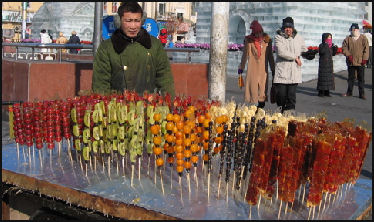
Fruit seller in Harbin
Among the locally consumed fruits are plums, grapes, apples. limes, pineapples, oranges, bananas, tangerines, coconuts, mangos, papaya, watermelons, cantaloupes and wide variety of local fruits. In southern China you can find things like guavas, rambutans (lychee-like fruit) lychees, custard apple (zurzat), bread fruit, passion fruit, jerek (pomelo), starfruit, and smelly but delicious durians.
Citrus fruits, which includes lemons, oranges, limes and grapefruit, originated in southern China and Southeast Asia. They made their way to the Middle East and were later introduced by Arabs to Europe.
Kumquats are popular in many parts of Asia. Chinese call them "golden oranges." More than 70 percent of China's citrus crop are mandarin oranges, which are smaller than regular oranges and have a thick easy-to-peel skin.
Chinese wolfberries have a strange, sweet, bitter, sightly meaty flavor. They are bright orange and are often added for medicinal reasons.
See Separate Article FRUITS AND VEGETABLES IN NORTHEAST ASIA factsanddetails.com ; FRUITS IN SOUTHEAST ASIA factsanddetails.com ; DURIANS AND MANGOSTEENS factsanddetails.com FOOD IN CHINA: DIET, EATING HABITS AND TRENDS factsanddetails.com ; HISTORY OF FOOD IN CHINA factsanddetails.com ; FOOD, DRINKS AND CANNABIS IN ANCIENT CHINA factsanddetails.com ; WORLD'S OLDEST RICE IN CHINA factsanddetails.com ; CHINESE CUISINE factsanddetails.com ; SNACKS, DESSERTS AND SWEETS IN CHINA factsanddetails.com ; RICE, TOFU, DUMPLINGS AND NOODLES IN CHINA factsanddetails.com ; REGIONAL CHINESE CUISINES factsanddetails.com ; FAMOUS CHINESE FOODS AND DISHES WITH INTERESTING, FUNNY NAMES factsanddetails.com ; WEIRD FOODS IN CHINA factsanddetails.com ; RESTAURANTS IN CHINA factsanddetails.com ; FAST FOOD AND FOOD DELIVERY BUSINESSES IN CHINA factsanddetails.com ; EATING CUSTOMS IN CHINA factsanddetails.com ; BANQUETS, PARTYING AND DRINKING CUSTOMS IN CHINA factsanddetails.com ; RICE: ITS HISTORY, AGRICULTURE, PRODUCTION AND RESEARCH factsanddetails.com; RICE AGRICULTURE IN CHINA factsanddetails.com; FIRST CROPS IN CHINA factsanddetails.com ;
Websites and Sources: Wikipedia article Wikipedia ; Eating China Blog eatingchina.com/blog ; Imperial Food, Chinese Government site china.org.cn; Wikipedia article on History of Chinese Food Wikipedia ; Chopstix chopstix.com ; Asia Recipe asiarecipe.com ; Chinese Food Recipes chinesefood-recipes.com : Food Tours in China, China Highlights China Highlights
RECOMMENDED BOOKS:“Asian Vegetables: Gardening. Cooking. Storytelling” by Stéphanie Wang, Caroline Wang , et al. Amazon.com; “A Cook's Guide to Chinese Vegetables” by Martha Dahlen Amazon.com; “Growing Chinese Vegetables in Your Own Backyard: A Complete Planting Guide for 40 Vegetables and Herbs, from Bok Choy and Chinese Parsley to Mung Beans and Water Chestnuts” by Geri Harrington Amazon.com; “Asian Ingredients: A Guide to the Foodstuffs of China, Japan, Korea, Thailand and Vietnam” by Bruce Cost Amazon.com; “The Chile Pepper in China: A Cultural Biography” by Brian R. Dott Amazon.com; Chinese Diet and Nutrition “The China Study: The Most Comprehensive Study of Nutrition Ever Conducted and the Startling Implications for Diet, Weight Loss, and Long-Term Health” by T. Colin Campbell PhD, Thomas M. Campbell II MD, et al. Amazon.com; “The Tao of Healthy Eating: Dietary Wisdom According to Traditional Chinese Medicine” by Bob Flaws Amazon.com; “The Tao of Nutrition” by Maoshing Ni Amazon.com; “The Five Elements Cookbook: A Guide to Traditional Chinese Medicine with Recipes for Everyday Healing” by Zoey Xinyi Gong, Cassie Zhang (Photographer) Amazon.com; “Your Guide to Health with Foods & Herbs: Using the Wisdom of Traditional Chinese Medicine” by Yifang Zhang Amazon.com; “Chinese Business Dinner Culture: Mistakes to Avoid and Critical Must Do’s to Gain Face, Impress Decision Makers and Close More Deals” by Justin Trosclair Amazon.com
Mangoes and Melons
In the Mao era mangoes were greatly treasured. After Mao received a box of them as a gift from the foreign minister of Pakistan he had some distributed among groups of Communist Party workers. The fruit were received as proof of Mao’s godlike love of his subjects and were treated with religious awe. Some of the mangoes were boiled down and made into a precious elixir; others were pickled in formaldehyde and preserved on altars. Afterwards copies of mangoes were preserved in cases like the bones of saints. A multitude of objects with images of them were created.
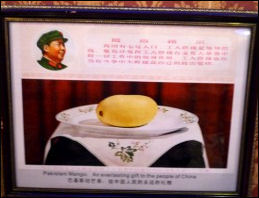
Mao and mangoes The mango craze began In 1968, when Mao decided to bring the Cultural Revolution movement back under the control of the Party. But officially he pronounced that from now on the working class should be leaders in everything. It was at precisely this time that Mao received a box of mangoes as a gift from the visiting foreign minister of Pakistan. The very same night Mao ordered that these exotic fruits should be presented to the workers. The mangoes were quickly seen as a symbol of Mao’s benevolence and devotion to the masses, and became the focus of cult admiration. The symbol soon entered popular culture, with mangoes decorating cups, bowls, cigarette packets, badges, blankets and other everyday objects. For more than a year China was gripped by mango fever. And then the mango vanished from the propaganda repertoire, as quickly as it had come.
The Chinese love to eat watermelon and watermelon seeds. Melon seeds are eaten like sunflower seed. The idea is to crack open the shell and eat the kernel inside. The Chinese are also fond of chestnuts. They roast them, eat them raw and slice them up, deep fry them and add them to dishes.
The oldest melon in China has been dated to the A.D. 4th century. The inner fruit of a melon, dated to 2,100 years ago, was found in the Shimonogo ruins n iMoriyama, Shiga Prefecture in Japan. The melon is native to Africa and came to Japan via the Middle East and India. Domesticated watermelon seeds dated to 4000 B.C. were found in the 1980s in southern Libya. Dorian Fuller of University College London told the New York Times, “The wild watermelon is a horrible, dry little gourd that grows in wadis of the northern savannahs but it has seeds you can roast up and eat.” The watermelon we eat was not developed until Roman times.
Exploding Watermelon, See Crops
Vegetables in China
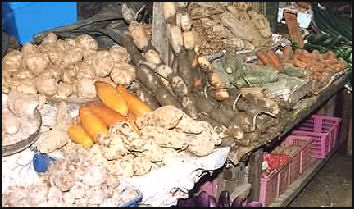
Common vegetables include spinach, cauliflower, celery, cucumbers, squash, white radish, green beans, snow peas, bean sprouts, water chestnuts, bamboo shoots, ginger, onions, tomatoes, peppers, eggplant, beets, mushrooms, potatoes and a wide variety of Chinese vegetables.
Asparagus is considered a real delicacy and often served at fancy banquets. Cucumbers are regarded as good for digestion and avoiding constipation. Danone introduced a cucumber-flavored yogurt in China that it hopes will tape into these sentiments. Potato consumption increased 40 percent between 2002 and 2007 in a large part because of fondness for Kentucky Fried Chicken and McDonald’s French fries.
Bok choy, Chinese cabbage, was once considered exotic in the United States but now is relatively commonplace. A common starter in China is chrysanthemum stems.
Mung beans are added to green noodles or sprouted into bean sprouts. They are one of the easiest beans to sprout. All you have to do is soak them for a few hours, strain, cover in a cheese cloth and place in a dark space. The are generally ready two or three days later when they sprout to a length of 1 inch or 1½ inches. Before they are ready to eat they are exposed to sunlight so that chlorophyll is manufactured.
Lotus flowers are grown commercially for their roots, which are sliced and soaked in syrup. Often grown in the autumn and winter in flooded rices paddies and ponds, they are harvested in December, often when the water is quite cold, by farmers who sink to their waists in mud and water and dig and pull the roots out of the ground by hand and clean them with well water in a hose.
In addition to being used as a construction and furniture-making material, bamboo is sliced and eaten. Bamboo shoots are gathered in the early spring by people who dig them up hand in bamboo groves. The best ones haven’t emerged from the ground yet and take some probing in the the earth to find.
The Chinese are developing a taste for organic food. Food safety scares have raised the demand from consumers. The biggest problem is trying to prevent people from passing off food as organic that really isn’t. The Chinese Ministry of Agriculture certifies products as having restricted amounts of agricultural chemicals with its popular “Green Food” label, which can be found on products ranging from fruit to noodles to beer.
Cabbage in China
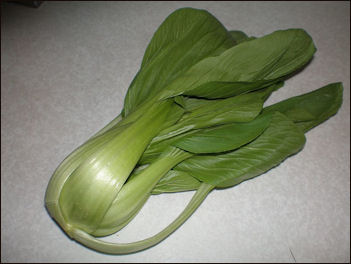
Brassica rapa chinensis
Cabbage is just as important to the Chinese diet as rice. During the cabbage harvest season in late November, some 600 million tons (50 pounds a person) of the leafy vegetable are bought into Beijing on trucks, horse-drawn carts and pedal powered three-wheelers. Selling for as little as a penny a head, the cabbages are piled into small hills on street corners and sidewalks. Sometimes the piles spill on to the streets, producing a traffic hazard for passing cars, taxis and buses.
Cabbage is the world's most widely consumed vegetable and one of the first to be harvested by ancient farmers. Native to the Mediterranean, it was eaten by Achilles in the Iliad and is believed to have been introduced to Europe and other parts of the world by the Romans. Today, cabbage is a staple in China, Korea and Europe and used to make everything cole slaw to kim-chi to stir-fried pork. There are hundreds of different kinds if cabbages. Some are perfectly round. Others are egg-shaped. Others are red or have wrinkled leaves.
The Chinese hang cabbage on clothes lines, soak it in water, stack it like firewood, and use it make it make dumplings and pickled and stir-fried dishes. "People will always buy cabbage," one man told the New York Times. "That's the food you get through the winter on." Another man said, "In the past there used to be nothing else to eat." Cabbages are not kept inside because central heating causes them to rot.
Unlike the soccer-ball-shaped cabbage popular in the west, Chinese cabbage is cylindrical with broad white leaves. In the West it often goes by its Cantonese name bok choy. According to an old communist saying, "When you've got your winter cabbage, in your heart you feel secure." During a good year a farmer can make a profit of $1,200 for selling 55,000 pounds of cabbage. One former cook, interviewed by the Washington Post, who lived off of disability payments of $11 a month bought 660 pound of cabbage.
Cabbage is commonly used as filling for dumplings in Beijing and northern China. In 2006, farmers grew so much cabbage prices dropped to record lows of only a few cents a head,
Importance of Cabbage to Chinese

bok choy
Cabbage was an important staple in 1950s and 60s when meat, fish and other kinds of vegetables were largely unavailable. Many people survived the Mao era on cabbage and turnips.
The old Drum Tower Outer Street New People’s Produce Market in Beijing sometimes draws customers by giving out free cabbage starting at around 5:30am. Some people wait in line for two hours to get cabbage that would cost four cents a head if they bought it. Many of those who wait in the line are retirees living on minimal pensions or people who had lost their jobs.
As the Chinese have become more affluent and greenhouses have made fresh vegetables available year round, more and more Chinese are abandoning cabbage in favor of spinach, garlic shoots, broccoli, eggplant, cauliflower and tomatoes, all of which can now be grown in winter greenhouses. When the supply of cabbage exceeds demand, consumers are told it is there "patriotic duty to buy it."
Cabbage is cheap and rich in vitamins and minerals. It is valued because it stays good a long time even when it is not refrigerated and is frost resistant and grows well in cold weather. Cabbage has a compact head surrounded by a few leafy leaves. It belongs to the same family of vegetables as turnips, Brussel sprouts, kohlrabi, kale, broccoli, cauliflower, collards, rape and rutabaga. The original cabbage plant had no head and was more similar to kale than cabbage.
Wild Chinese Grass Used as Food and Medicine
Cordate houttuynia is a vivacious herbal plant. It Chinese name means "fishy grass" because its leaves and stalks can give off the smell of fish after rubbing. Cordate houttuynia is found in widely scattered locations in the southern provinces of China. It can also be found in Northwest China, and parts of North China and Tibet. Cordate houttuynia usually grows in shady slopes, on the ridges of crop fields, riversides, or humid grassland. When cordate houttuynia plant is young, the part under its neck crawls on the ground surface and looks like root growing in shallow soils, and it is white and has roots beside the joints. The upper part of its stalk stands upright, which is heart-shaped or egg-shaped and green and purple in color. The flowering period of cordate houttuynia is from May to June, and its fructifying period is from October to November. Cordate houttuynia has great vital forces; they can survive by just inserting a piece of roots or stalks into humid soil, and its branches can also sprout and regenerate when inserting into soil. [Source: Chinese Academy of Sciences, kepu.net]
In Xishuangbanna, cordate houttuynia is a consumed as a wild vegetable. To prepare you first need to get rid of the woolly roots on the stalks; then,cut them into small sections of 2-3 centimeters in length after cleaning (some young leaves can also be added). After that you add some vinegar, sauce, pepper powder, and monosodium glutamate, then mix them up. The dish is crisp, but has a fishy smell. The underground stalk and young leaves can be fried, boiled or braised. This produces a faint but fishy smell. The stalks and leaves are then made into a crisp and appetizing pickled vegetable.
Because wild cordate houttuynia has a strong fishy smell, when people eat it for the first time they generally don’t like it. Commercial development of it has not had so much success. Among its proponents are doctors In Xishuangbanna, cordate houttuynia is a traditional medicinal plant. Traditionally Chinese medicine doctors say it has a cold nature, and has the effects of clearing heat, detumescence, and diurisis. It is often used to cure canker sores, to clear heat, and to cure dropsy and whites. It is also used to treat pulmonary and urinary ailments.
Studies of cordate houttuynia have revealed that peculiar fishy smell comes from a chemical in its volatile oil — decanoy acetaldehyde, which has a major antibacterial element. Clinical experiments indicate cordate houttuynia may help treat infections of the upper aspiratory cavity, bronchitis, arthritis, coughs, conjunctivitis and infection of the urethral channel. In addition, cordate houttuynia may improve the immunity of the body and the gulping capacity of the white cells; therefore, it may also has the effects for stopping pains, cough, and bleeding, as well as facilitating the regeneration of tissues, enlarging capillary vessels, and improving blood circulation etc. Cordate houttuynia can be planted as a vegetable. If it is further developed, it can also be used as medicinal materials for manufacturing Western and Chinese medicines; therefore, it may enjoy a broad market prospect in the future.
Poppy Seeds Banned in China Because of Link to Opium
Reporting from Beijing, Barbara Demick wrote in the Los Angeles Times, “On a stroll through the aisles of the wholesale spice market in southeast Beijing, visitors inhale the fragrances wafting from the burlap sacks of cardamom, star anise, cinnamon, clove, fennel, turmeric and a dazzling selection of peppers, from the tingling to the deadly hot.A vendor looks up and smiles in anticipation of a sale. "What are you looking for?" When she is told poppy seedpods, the smile vanishes. "Mei you," she snaps — "Don't have" — and abruptly turns away. Forget about MSG. The most controversial spice these days in China is the pingpong-ball-sized pod that contains poppy seeds. [Source: Barbara Demick, Los Angeles Times, October 21, 2013 ~\~]

Brassica rapa
“For years, some chefs here have been slipping a powder of ground pods into certain meat and seafood dishes under the impression that it makes the food tastier and has an addictive quality that brings customers back for more. But authorities say the poppy pods are a dangerous opiate and have launched a crackdown amid an overall tightening of food safety regulations. The pods — or more commonly a powder made from ground pods — have vanished from spice markets, where they used to sell for about $70 a pound.” ~\~
In October 2013, “24 people in Shanghai were indicted on a range of food safety charges that included adding poppy pods to food. Prosecutors in particular cited a restaurant that they said had been adding the banned poppy powder to steamed crayfish. In the southern city of Guangzhou, an investigative report this month said the city's food and drug administration had conducted spot checks of 70 restaurants and found two where the poppy was added. The government's crackdown is part of a larger campaign against illegal food additives, such as melamine, which caused a scandal when it was added to milk powder.” ~\~
In May 2013, “the Supreme People's Court issued an interpretation saying that violators could potentially receive prison sentences of up to five years for spiking food with poppy seed shells. So far, it appears that restaurants caught using the spice have been penalized only with fines. "This is not like MSG," said Pan Siyi, dean of the school of food science and technology at the Huazhong Agricultural University in Wuhan. "The poppy is considered to be a drug." Pan says the seedpod of the poppy contains more opiates than the seeds themselves. "Added to food, it can enhance the flavor and aroma," he said. "It can give you a better appetite and make you more alert and excited. I think it is an exaggeration to say you'll get addicted from eating it once or twice, but you could become dependent if you were eating a large quantity over a long period of time." ~\~
Opium Poppy Pods: the Addictive Hot Pot and Crayfish Spice
Barbara Demick wrote in the Los Angeles Times, Chinese cooks add opium poppy pods “to all types of cuisine, depending on the region. In Shanghai, it is often crayfish; in the Guangzhou case, it was detected in the cooking broth used for a popular Cantonese stewed meat. In northern China, the poppy pod — referred to as da yan ke, or "big smoky shells," after the slang for opium — is added to hot pot, the spicy stew cooked at the table. Connoisseurs say it adds a certain je ne sais quoi to the flavorful dish. [Source: Barbara Demick, Los Angeles Times, October 21, 2013 ~\~]
"Ah, the aroma and the taste are very flavorful," said Xin Jing, a 45-year-old businessman from the northern city of Harbin, who was shopping at the spice market in Beijing. "It is hard to describe. Maybe a little like sesame. Once you have tasted it, you want to eat more." Xin says the first few times he had hot pot with the poppy additive he didn't realize what it was that made the food so delicious. Indeed, in several cases, restaurants have gotten busted only when their customers later got positive readings in drug tests.” ~\~
In March 2013, “two young women working in a karaoke club in Wuxi, near Shanghai, led police to a crayfish restaurant where they had dined at 1 a.m. after work. Sure enough, the crayfish tested positive for opiates. Upon questioning, the chef admitted that he had gotten poppy seedpods from his sister, who worked at a traditional medicine clinic, and added them to the cooking oil. The restaurant had opened just 18 days before and had already generated more than $9,000 in revenue, according to a report in the Yangzi Evening News. ~\~
“Until recently, poppy pods could be found in wholesale spice markets in Beijing and elsewhere in China, although they were often kept out of public view and sold only to trusted customers. According a report in the Beijing Times, people usually didn't even name the spice but asked only for "that stuff." At the Dayanglu market in Beijing, vendors flinched when asked about the spice that could not be mentioned by name. Each insisted that he or she had never sold it. When asked how she knew about it, one vendor said, "I saw a report about it on TV." "It has always been illegal, but recently they have gotten very strict," said Wang Jinzhi, one of the few vendors willing to speak about poppy pods. "Nobody would dare sell it now." ~\~
Wenwanhetao Walnuts: Don’t Eat ‘Em Roll Them
In China, twirling a pair of walnuts around in one's hand a persons hand like worry beads or a pair of silver balls serves as a form of hand exercise, meditation and outlet for nervous energy. Walnuts have been used as toys in China's imperial courts as early as A.D. 220, but were championed by officials during the Qing Dynasty (1644-1912) and have been status symbols ever since, exchanged among the country's elite. In recent years, demand for them grown as China's economy has expanded. They are especially popular among nouveau riche men and gangsters who sell them on the black market. [Source: Tom Hancock, CNN, October 14, 2014]
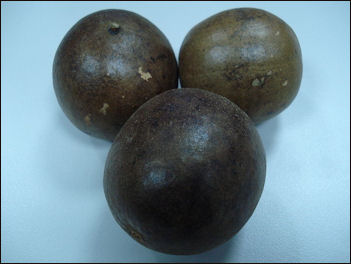
Fructus Momordicae
Aya Igarashi wrote in the Yomiuri Shimbun, “In and around Beijing, you’ll often see men rolling two walnuts in one of their hands. Called “wenwanhetao,” these are different from edible walnuts. Wenwanhetao were reportedly known as marks of status among the imperial family during the Qing Dynasty and eventually spread among common people. In addition to promoting good blood circulation by stimulating the palm, wenwanhetao can increase in market value. Shiny walnuts that have been rolled carefully for a long time are popular among people who use them. [Source: Aya Igarashi, Yomiuri Shimbun, January 6, 2015 ==]
“A variety of walnuts are available at the wholesale store run by Lu Gong, 40, of Heilongjiang Province in Beijing’s famous Pan Jia Yuan Antique Market, ranging from a highly affordable pair costing 2 yuan (about ¥40) to ultraexpensive pairs costing tens of thousands of yuan. They are named according to their patterns, with such monikers as “full of stars” or “giraffe pattern.” Told by Lu that the finest walnuts have a special feel, I tried to roll a pair of 10,000 yuan (about ¥190,000) walnuts with a name meaning “Chinese big flower.” Maybe it was because I already knew the price, but I felt as if my blood circulation had suddenly improved. ==
Pair of Walnuts Sell for $40,000 in China
In 2013, a pair of walnuts sold for over $40,000. Leo Lewis wrote in The Times: “In the back alley markets of southern Beijing, young men in designer clothes are taking bets on the state of this year’s crop, paying $680 “blind” for a pair of lion’s head walnuts still in their fleshy outer jackets. Connoisseurs believe the unique knobbly shapes of the nut casings work as worry beads. In 2007, a good pair of walnuts could be bought for around $30, but speculative investment and the walnut’s new status as an expensive gift means prices have exploded. [Source: Leo Lewis, The Times, September 5 2013]
A year later, Tom Hancock of CNN wrote: “Grinning with pride, a Chinese farmer held out two precious walnuts — globes so precisely symmetrical that consumers in search of hand massages value them more highly than gold. "Prices have skyrocketed, " said Li Zhanhua, standing in the shade of the leafy green walnut trees which have made him a small fortune. "Years ago, we could never have imagined this." Rolling a pair of walnuts between palm and fingers — believed to improve circulation — has been a Chinese pastime for hundreds of years. "Mainly the walnuts are good for the body, that's why people play with them, " Li said, plucking a deep brown pair out of a display case.[Source: Tom Hancock, CNN, October 14, 2014]
“Just a decade ago, Li and his neighbours ploughed a hard-scrabble existence growing wheat and corn, but now take regular holidays from their mountainside village and own imported cars as well as apartments in a nearby city. Li once sold a prized pair for 160,000 yuan [$25,000], but added: "Even a relatively ordinary pair of walnuts can be more expensive than gold, in terms of weight." "We are all grateful for the huge changes the walnuts have brought us. All of our development depends on them, " said Li, who says he harvests up to 2 million yuan ($325,000) a year from his nuts.
Buying and Selling Super Expensive Walnuts in China
Tom Hancock of CNN wrote: “Collectors are not interested in the edible kernel, but instead value its ridged brown shell, which grows concealed beneath a green husk. Farmers root through truckloads of produce to find pairs with the most symmetrical pits and ridges, which bring the highest prices. Size — the bigger the better — and colour also play a role, with deeper browns more valuable. "Each one is unique, and becomes red as you play with it, " said Li's neighbour Zhang Guifu, gripping a high-pressure hose while spraying a box of freshly husked nuts. "It's valuable as a collector's item and for boosting brain fitness." Different varieties' names are as colourful as the nuts themselves. There is the "government official's hat", whose pitted surface and form recall the tasselled headwear of Qing dynasty courtiers, as well as the "chicken's heart" and "lantern", named for their shapes. [Source: Tom Hancock, CNN, October 14, 2014]
“At an open air market, dozens of salespeople sat behind walnuts placed in rows or perched on revolving plastic podiums. "At the high point of the season this whole area is packed with cars and people like a sea, you can't even move, " said vendor Lin Changzhu, whose namecard shows two deep red nuts. But local fortunes have encouraged another growth industry — walnut theft. To prevent pilfering, farmers like Li and Dong have fortified their fields with barbed-wire fences, grizzly guard dogs and security cameras.
“With prices appreciating long term, investors facing low interest rates on bank deposits have turned to walnuts as a store of value, according to Chinese reports, and speculating on unpeeled walnut fruit has become a form of gambling, which is generally banned in mainland China. In a practice called "betting on skin" buyers pay a fixed price for the nuts before their green outer covering has been removed, hoping that what is inside will be worth more than they shelled out.
“Walnuts have been sold for generations in Beijing's Shilihe market, where stalls also offer specialised walnut oil and brushes. Dozens of mostly middle-aged men crouched smoking and commenting on lines of fruit set out on black cloth. After prodding and measuring a series of specimens, and a prolonged debate, Beijinger Miao Yaoge rolled out 2,000 yuan in crisp red notes, before watching as the vendor cut open his chosen pair with a kitchen knife. "Look, the husk is thin, " the seller exclaimed, suggesting a larger nut and prompting a flicker of a smile from Miao, 45, an imposing figure with a shaved head and a white tracksuit. As they were given a final buffing, Miao — who reckoned they were worth around 2,500 yuan, giving him a profit on the deal — said: "This is Chinese culture. I'm happy with my walnuts."
Image Sources: Wiki Commons, Beijen.com, Julie Chao
Text Sources: New York Times, Washington Post, Los Angeles Times, Times of London, National Geographic, The New Yorker, Time, Newsweek, Reuters, AP, Lonely Planet Guides, Compton’s Encyclopedia and various books and other publications.
Last updated October 2021
